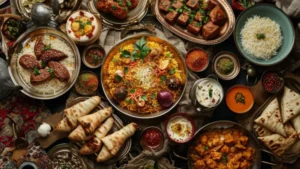Exploring the intricate relationship between cuisine and culture unveils a rich tapestry of flavors, traditions, and heritage passed down through generations. Traditional foods not only nourish the body but also serve as potent symbols of identity, history, and social connections. This comprehensive breakdown examines the intersection of cuisine and culture, delving into the significance of traditional foods, their cultural contexts, and the ways in which they reflect societal values and customs.

Introduction to Cuisine and Culture
Cuisine and culture are deeply intertwined, with food serving as a cornerstone of cultural identity across the globe. Traditional foods are often steeped in history, shaped by geography, climate, religion, and cultural practices. These culinary traditions offer insight into a society’s values, beliefs, and social structures, making them a rich subject for exploration.
Significance of Traditional Foods
Traditional foods hold profound significance within a culture, serving multiple functions beyond mere sustenance:
- Cultural Identity: Traditional foods are a source of pride and identity, reflecting a community’s unique heritage and culinary traditions.
- Social Cohesion: Sharing meals is a universal human experience that fosters social bonds and strengthens community ties.
- Historical Legacy: Many traditional recipes have been passed down through generations, preserving cultural heritage and connecting individuals to their ancestors.
- Rituals and Ceremonies: Traditional foods play a central role in religious ceremonies, festivals, and life events, imbuing these occasions with cultural meaning and symbolism.
Cultural Context of Traditional Foods
The culinary landscape of a region is shaped by a myriad of cultural influences, including:
- Geography: The availability of local ingredients and natural resources influences regional cuisines. Coastal areas may feature seafood-based dishes, while inland regions may showcase hearty meat and grain-centric fare.
- Climate: Environmental factors such as temperature, rainfall, and altitude impact agricultural practices and food preservation techniques, shaping the flavors and ingredients used in traditional dishes.
- Religion and Beliefs: Religious dietary restrictions, taboos, and culinary customs influence food preparation and consumption patterns. For example, halal and kosher dietary laws dictate specific methods of animal slaughter and food preparation.
- Historical Influences: Migration, colonization, trade routes, and conquests have introduced new ingredients, cooking techniques, and flavor profiles to traditional cuisines, resulting in fusion cuisines and culinary syncretism.
Culinary Tour of Traditional Foods
Asia
Asia boasts a diverse culinary landscape, with each country offering a unique array of traditional dishes:
- Sushi (Japan): A symbol of Japanese cuisine, sushi features vinegared rice topped with fresh seafood, vegetables, or egg, reflecting Japan’s coastal geography and reverence for seasonal ingredients.
- Kimchi (South Korea): A staple of Korean cuisine, kimchi is fermented vegetables (usually cabbage or radishes) seasoned with chili peppers, garlic, and other spices, showcasing Korea’s preservation techniques and love for spicy flavors.
- Pad Thai (Thailand): A popular Thai street food, pad Thai is a stir-fried noodle dish made with rice noodles, shrimp or tofu, bean sprouts, peanuts, and tamarind sauce, highlighting Thailand’s vibrant street food culture and culinary creativity.
- Biryani (India): Biryani is a fragrant rice dish layered with spiced meat (typically chicken, lamb, or goat), aromatic herbs, and caramelized onions, representing the rich culinary heritage of Mughal-influenced Indian cuisine.
Europe
Europe’s culinary traditions are as diverse as its landscapes, reflecting centuries of cultural exchange and regional specialties:
- Pizza (Italy): Originating from Naples, pizza features a thin crust topped with tomato sauce, cheese, and various toppings, embodying Italy’s passion for simple, flavorful ingredients and artisanal craftsmanship.
- Croissant (France): A quintessential French pastry, the croissant is a buttery, flaky pastry known for its crescent shape and golden-brown exterior, epitomizing France’s culinary finesse and dedication to pastry-making.
- Paella (Spain): Hailing from Valencia, paella is a saffron-infused rice dish cooked with a variety of proteins such as chicken, rabbit, seafood, and vegetables, reflecting Spain’s diverse culinary heritage and Moorish influences.
- Haggis (Scotland): A traditional Scottish dish, haggis is made from minced sheep’s offal (heart, liver, and lungs) mixed with oatmeal, suet, onions, and spices, encapsulating Scotland’s rustic gastronomic traditions and love for hearty fare.
Africa
Africa’s culinary landscape is as diverse as its people, with each region offering its own array of traditional dishes:
- Tagine (Morocco): A slow-cooked stew made with meat, poultry, or fish, vegetables, dried fruits, and aromatic spices, cooked in a cone-shaped clay pot called a tagine, showcasing Morocco’s vibrant spice trade and North African flavors.
- Injera (Ethiopia): A sourdough flatbread made from teff flour, injera serves as a versatile staple in Ethiopian cuisine, used as a utensil to scoop up various stews and dishes, symbolizing Ethiopia’s culinary ingenuity and communal dining traditions.
- Bobotie (South Africa): A savory-sweet casserole dish made with spiced minced meat (usually beef or lamb) topped with an egg custard, and served with rice or bread, representing South Africa’s multicultural heritage and Cape Malay influences.
- Jollof Rice (West Africa): A one-pot rice dish cooked with tomatoes, onions, peppers, and spices, jollof rice is a beloved West African staple, served at festive occasions and celebrations, embodying the region’s love for bold flavors and communal feasting.
North America
North American cuisine










